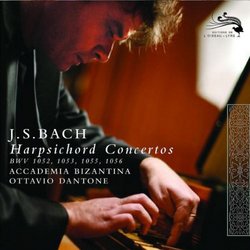| All Artists: Johann Sebastian Bach, Ottavio Dantone, Accademia Bizantina Title: Bach: Harpsichord Concertos Members Wishing: 1 Total Copies: 0 Label: Decca Import Release Date: 7/7/2008 Album Type: Import Genre: Classical Styles: Forms & Genres, Concertos, Historical Periods, Baroque (c.1600-1750), Symphonies Number of Discs: 1 SwapaCD Credits: 1 UPC: 028947593553 |
Search - Johann Sebastian Bach, Ottavio Dantone, Accademia Bizantina :: Bach: Harpsichord Concertos
 | Johann Sebastian Bach, Ottavio Dantone, Accademia Bizantina Bach: Harpsichord Concertos Genre: Classical |
Larger Image |
CD Details |
CD ReviewsCrystal Clear Performance With Nowhere to Go M. Figg | USA | 12/03/2009 (3 out of 5 stars) "Ottavio Dantone is the harpsichord soloist with one string player per part in the orchestra, so what you get is essentially a string quintet with keyboard soloist/continuo. On first listening to this disc, I was struck by the clarity this brought to the musical whole. Period instruments are known for allowing greater transparency in orchestral textures, and the smaller forces allowed me to zero in on each individual part of Bach's polyphonic whole. With heavily contrapuntal music this is especially useful, as it makes sure the composition never congeals into a dense, inundating soup.
It was an initially refreshing experience of Bach, yet as I kept listening I noticed a gradual slackening of the rhythm. In addition to textural clarity, Bach's music also requires a certain rhythmic lilt, almost "swing" so that the voices don't just blend together but seem to "dance" in violinist Hilary Hahn's words. I can't tell if Dantone takes this too literally or not enough, yet I noticed that the harpsichord solos seemed to take liberties with the pulse that may have been intended for dramatic effect, but instead seemed to only detract from the overall drive of the performance. When the orchestral tutti reappear this rhythmic slackening is felt even more. In the more lyrical slow movements this "mannered" approach to meter becomes more of an asset, lending an intimate, smokey feeling to these sections that reminds the listener of this music's origins at the Café Zimmerman; truly some Baroque era café Jazz! The tick-tock melody of the A Major/BWV 1055 concerto is the most successful complete work, but Dantone's handling of the famous, intense, proto-Romantic D minor concerto is incredibly disappointing, like a train whose engines you can feel revving with no acceleration. For the sake of comparison, Rinaldo Alessandrini as soloist and conductor with the Concerto Italiano orchestra remains my top choice for these concertos. This is a larger orchestra that still manages to play with laser clarity and can still turn creamy warm as needed, with fast yet appropriate tempi delivered by a technically adept, emotive soloist. The bassoon in the continuo on the F major concerto (the one that includes recorders) is a very rich, sonorous touch. The disc is out of print, but if your library has a copy grab it! One place NOT to start might be the complete set by Trevor Pinnock with the English Concert: their big booming orchestra, superfast tempos and clattery keyboards say more about the performers than the score. " |
